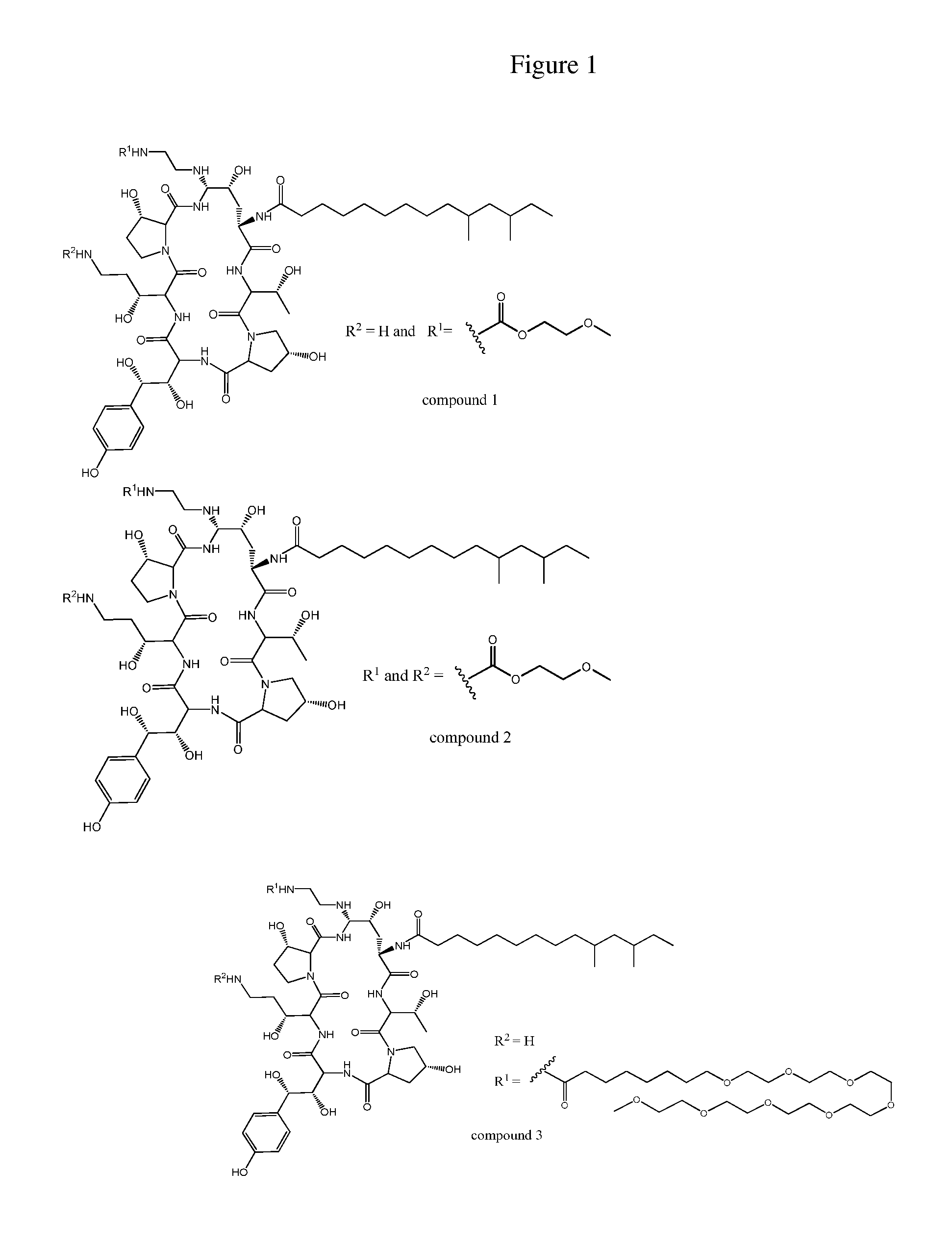Dosing regimens for echinocandin class compounds
a technology of echinocandin and compound, applied in the field of dos, can solve the problems of limited use, continuing challenge in the development of antifungal treatment regimens, and great challenge in modern health care delivery, and achieve the effect of increasing the oral bioavailability of drugs
- Summary
- Abstract
- Description
- Claims
- Application Information
AI Technical Summary
Benefits of technology
Problems solved by technology
Method used
Image
Examples
example 1
Pharmacokinetics Following Intravenous Administration in Beagle Dogs
[0188]Echinocandin class compounds were administered to beagle dogs weighing approximately 6-10 kg. Each compound was dosed at 1.4 mg / kg in aqueous saline (with or without 0.5% Tween) over course of 1-10 minutes. Diphenhydramine was kept on hand in case the dogs demonstrated a histamine response. The dogs were fasted at least 12 hours prior to each dosing and offered food after the 4-hour blood sample was taken; water was withheld for 1 hour prior to and 4 hours following each dosing event. The dose for each animal was based on its most recent body weight. The test article was injected intravenously via a catheter placed in the cephalic vein as a slow bolus.
[0189]Blood was collected via the jugular vein. All blood samples (˜1 mL each) were collected into K3EDTA tubes. Following blood collection, the samples were immediately inverted several times and were held on wet ice pending centrifugation. The samples were cent...
example 2
Formulation for Oral Administration
[0193]The following formulations can be used in the methods, kits, and compositions of the invention.
[0194]Exemplary oral formulations of the invention are described in Table 2.
[0195]
TABLE 2FormulationCompositionConcentrationFormulation 1Echinocandin class10.0 mg / mLcompoundDodecyl Maltoside 3% (w / w)Tween 20 1% (w / w)Saline 96% (w / w)Formulation 2Echinocandin class10.0 mg / mL(emulsion)compoundLabrasol ® 40% (w / w)Plurol Oleique 10% (w / w)Labrafac ®6.25% (w / w)Propylene glycol6.25% (w / w)Water37.5% (w / w)Formulation 3Echinocandin class10.0 mg / mLcompoundMono glyceryl decanoate 4% (w / w)Tricparin 4% (w / w)Tween 20 1.5% (w / w)Tween 800-0.8% (w / w) NaOAc buffer (0.1M, pH 5-90.5% (w / w)6)Formulation 4Echinocandin class10.0 mg / mLcompoundLaureth 126.07% (w / w)Tween 201.16% (w / w)Saline92.8% (w / w)Formulation 5Echinocandin class10.0 mg / mLcompoundSodium caprate 3% (w / w)Sodium laurate 3% (w / w)Phosphate buffer (0.1M, 94% (w / w)pH 7.4)Formulation 6Echinocandin class 7.5 mg...
example 3
Pharmacokinetics Following Oral Administration in Beagle Dogs
[0196]Echinocandin class compounds were administered to beagle dogs weighing approximately 6-10 kg. Each animal received the appropriate prepared test article in a single oral capsule dose at a target dose level of about 7-10 mg / kg Immediately after dosing, each animal was offered 20 mL-30 mL of water orally (Groups 1-4) or 30 mL of water orally to assist in swallowing the capsule.
[0197]Animals were treated and blood samples were drawn and analyzed as provided in Example 1.
[0198]The bioavailability of each oral dose formulation was estimated by comparison to intravenous plasma concentration data in dogs from Example 1. The results provided in Table 3 show the oral bioavailability for the echinocandin class compound in saline (formulation 11), and the improvement over saline with the use of a formulation of the invention.
[0199]
TABLE 3Oral Dosing Results1% BAinImprovement3Compoundsaline2Formulation(% BA)Anidulafungin7.80%52....
PUM
| Property | Measurement | Unit |
|---|---|---|
| concentration | aaaaa | aaaaa |
| concentration | aaaaa | aaaaa |
| concentration | aaaaa | aaaaa |
Abstract
Description
Claims
Application Information
 Login to View More
Login to View More - R&D
- Intellectual Property
- Life Sciences
- Materials
- Tech Scout
- Unparalleled Data Quality
- Higher Quality Content
- 60% Fewer Hallucinations
Browse by: Latest US Patents, China's latest patents, Technical Efficacy Thesaurus, Application Domain, Technology Topic, Popular Technical Reports.
© 2025 PatSnap. All rights reserved.Legal|Privacy policy|Modern Slavery Act Transparency Statement|Sitemap|About US| Contact US: help@patsnap.com



